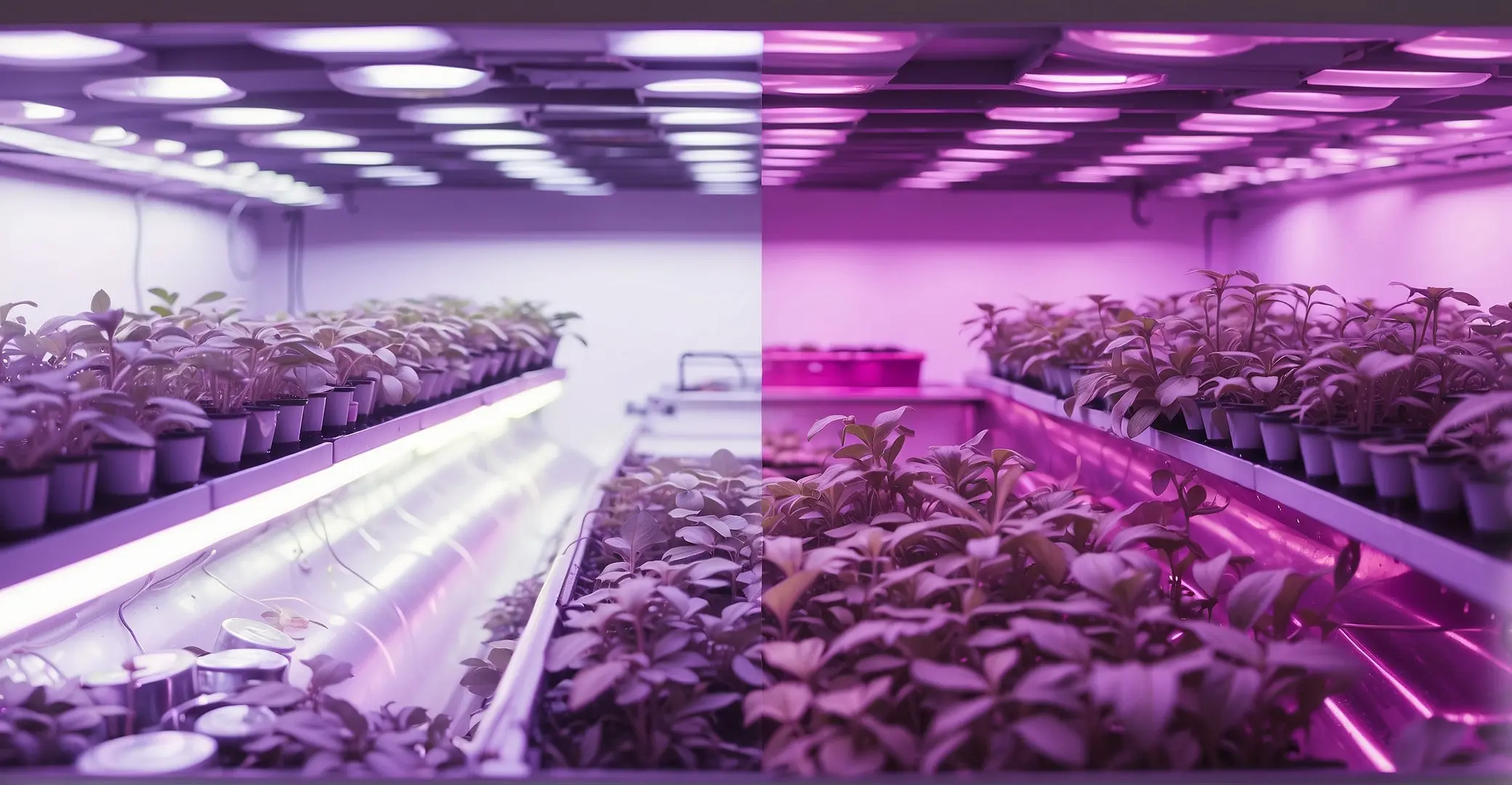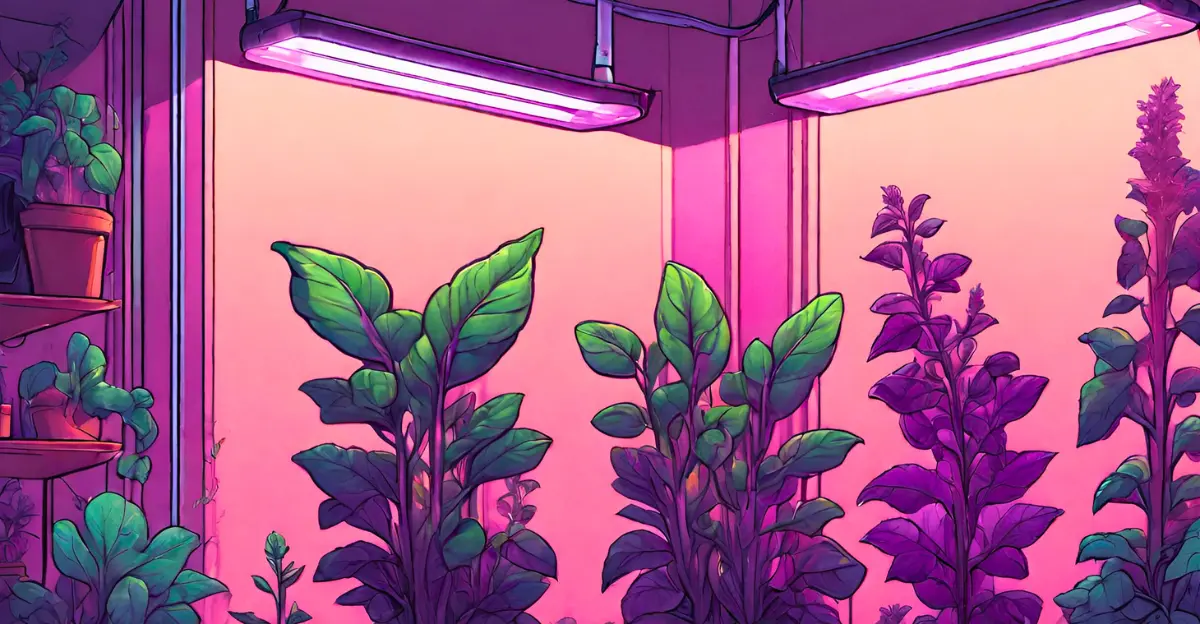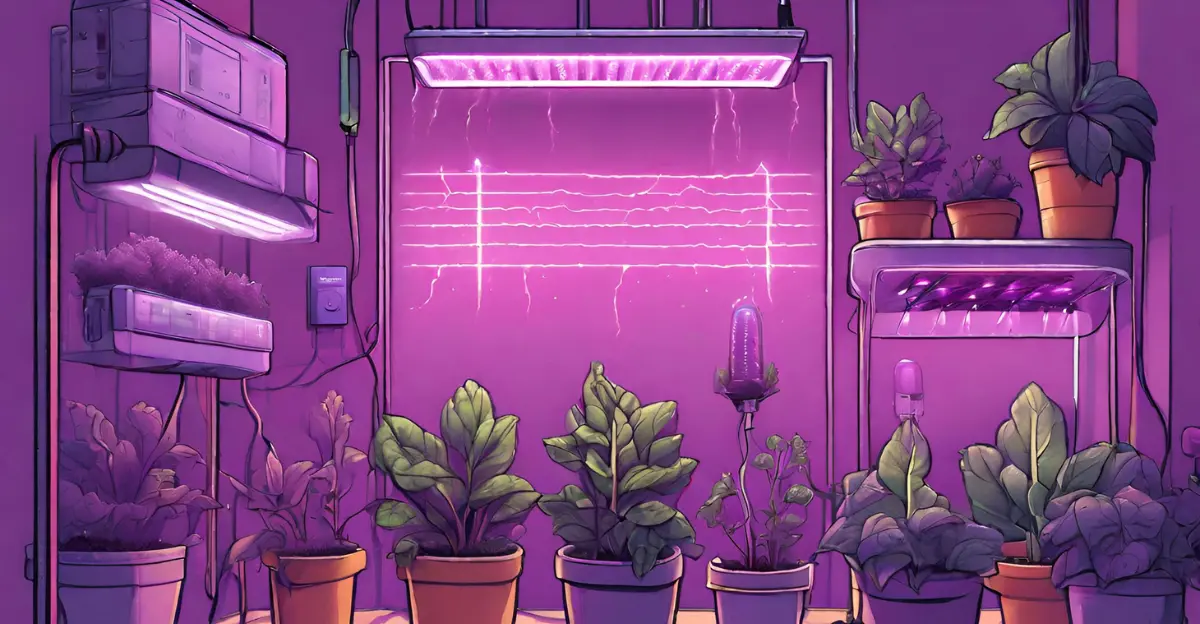Purple Grow Light vs White Light: The 2024 Expert Guide

Deciding between “purple” and “white” LED grow lights used to feel like a random choice for indoor gardeners based on vague manufacturer claims.
But it doesn’t have to be!
Research has confirmed light spectrum makes a significant impact—influencing, for instance, over 25% higher plant growth under certain red/blue LED wavelengths compared to white light in pak choi greens.
That’s just one example but I promise there will be more.
In this guide, we’ll demystify the debate once and for all by directly comparing these two incredibly popular lighting options across every metric that matters.
Let’s get started right away.
Quick Key Takeaways
Purple Grow Lights

So why do many LED grow lights appear vivid purple, almost like a blacklight?
It comes down to the wavelengths of light the LEDs emit.
These fixtures utilize specific blue and red light wavelengths that plants readily absorb for photosynthesis and growth.
Our eyes perceive the combination of intense blue at 400-500 nm and red at 600-700 nm wavelengths as purple.
More narrowly focused “monochromatic” wavelengths enable the LEDs to operate more energy efficiently (source).
But does this translate to better results for your indoor crops?
Let’s explore the unique upsides and downsides of purple grow lights.
Pros of Purple LED Grow Lights
Going purple can pack some nice perks:
Cons of Purple LED Grow Lights
Potential limitations to factor:
White Grow Lights

When researching grow lights, you’ll frequently encounter “full spectrum white” options claiming to mirror natural sunlight indoors.
These LED fixtures utilize blue, red, and generally green light blended to appear white (around 5000K-7500K) to the human eye.
Manufacturers market them as versatile for all plant growth stages, unlike more targeted “blurple” lights.
But a key distinction lies between lights balanced for human vision versus plant photoreceptor optimization.
Let’s explore the unique upsides and downsides white LED grow lights offer.
Pros of White Grow Lights
Some nice perks white light provides include:
Cons of White Grow Lights
Potential limitations to factor:
White LEDs strike an effective balance between plant needs and human vision/aesthetics. They facilitate healthy cultivation for most species without additional lighting.
However, if maximizing photosynthetic efficiency, growth speed, and flowering sites are critical priorities, consider supplementing with targeted red and blue light.
Ultimately, white LEDs present a versatile “set and forget” indoor growing option.
But those seeking to meticulously optimize light quality and quantity should compare tailored lighting mixes for each growth phase.
With that said, let’s get into a head-to-head comparison.
Ease of Use
When deciding between LED grow light options, an important consideration is the ease of actually using the lights daily in your space.
In this section, we compare purple and white grow lights for installation, adjustability, and user-friendliness of controls.
Installation and Setup Steps
Purple grow lights consisting solely of red and blue LEDs tend to be simpler to install, as they usually come ready to use out of the box.
White full-spectrum LED grow lights may have more complex controls and settings that require initial adjustment.
However, full-spectrum white lights allow easier height adjustments as plants grow compared to more focused red/blue lights.
Having a balance of color wavelengths reduces the risk of light burn or overexposure.
Adjusting Settings
Most white full-spectrum LED grow lights nowadays come with intuitive controls to adjust color balance, intensity, timers, etc. This allows adapting the light as plants grow.
In contrast, most purple grow lights have fixed red/blue wavelength ratios that can’t be adjusted. The only control is usually light intensity/dimming.
Full spectrum lights therefore provide more flexibility to cater to different growth stages and plant types. Purple lights are more rigid and suited mostly for flowering/fruiting plants.
User-Friendliness of Controls and Operation
White full spectrum lights give a more natural growth environment for the gardener, avoiding the harsh purple glow. This improves the growing experience.
Additionally, full-spectrum lights make plant health and color easier to monitor visually compared to colored wavelength-specific lights.
KEY TAKE HOME: While purple grow lights are simpler initially, full-spectrum white LED systems tend to provide better ease of use over time with more intuitive controls and flexibility for different growing needs. Their broader light also creates a more natural and pleasant environment.
Impact on Growth

Multiple studies have found that plants grown under purple LED lights have faster growth rates compared to white light in the initial stages. For example:
So while purple light promotes faster initial growth, over longer durations plants seem to adapt and grow better under full-spectrum white or a broader-spectrum grow light.
Impact on Yield
In terms of yield, studies have found that white light results in higher harvests compared to purple light:
So while purple light might increase early vegetation growth, research conclusively shows that white light results in superior crop yield and harvest size.
SIDENOTE: Results vary for other crops. More research is needed to conclusively determine if white light produces superior yields across all crop types.
Experienced growers recommend using a mix of red, blue, and white for the best results.
KEY TAKE HOME: For the fastest growth purple lights are ideal, but for maximum yield and crop quality, white lights or a combination of red, blue, and white spectra works best.
Electricity Usage & Efficiency

Purple LED grow lights are generally more energy efficient than white LED grow lights.
Purple lights utilize specific wavelengths optimized for photosynthesis, while white lights emit a broader spectrum with wavelengths that plants don’t use efficiently.
In a study comparing multiple LED light recipes, purple LEDs with a combination of blue and red light had the highest photosynthetic efficiency. White LEDs and sunlight were less efficient at driving photosynthesis.
Another study in a commercial hydroponic lettuce greenhouse found that replacing white fluorescent lights with optimized purple LEDs reduced electricity usage for lighting by 10-42% while increasing plant biomass.
Furthermore, LED lights produce very little heat compared to other grow light technologies like high-pressure sodium or metal halide. This reduces electricity demand for cooling and ventilation.
However, the heat output of white vs purple LEDs has not been directly compared in published research. But in general, more electricity-efficient lighting would produce less waste heat.
Setup Costs
When budgeting your indoor garden investment, an obvious area of focus lies in the upfront setup expenses.
From grow light fixtures to tents, fans, nutrients, and more, costs add up quickly.
In this section, we’ll break down how initial purchase prices and additional equipment needs compare between purple vs white LED lighting systems.
Purchase Prices for Starter Systems
For small growing areas like 2×2 ft tents, purple LED grow light starter kits tend to have cheaper upfront costs compared to full-spectrum white LEDs.
A basic 100W dual-head purple LED panel adequate for a mini grow tent costs around $60-100. In contrast, a similar output 100W full spectrum white LED generally runs $100-150.
Of course, more advanced LED systems with added automation and features can cost $200+ even for mini grow tents.
But in general, those just looking for a basic, affordable LED light panel to start will pay less upfront for targeted purple LEDs.
Scaling Up: 4×4 ft Tent Setup Example

The cost picture changes more when scaling up to a larger tent size like 4×4 ft and adding more growing equipment.
Now your lighting needs to increase to around 300W-600W power, depending on factors like desired plant density.
In this range, LED grow lighting systems start incorporating a blend of both red, blue, AND white light wavelengths.
So comparison between “purple panel” and “white light” blurs as most kits utilize both spectrums.
Here’s an example complete setup cost estimate:
In total, an advanced automated LED grow kit adequate for a 4×4 ft tent generally runs $500 to over $1000 once all equipment is accounted for.
Differences in costs for LED lighting power and features are just one portion of the complete budget.
KEY TAKE HOME: For starter spaces, targeted purple LED lights tend to be most budget-friendly. But at higher power levels and larger growing areas, kits mix both purple and white light wavelengths. And additional costs like grow tents, ventilation, nutrients, etc. make up a major portion of overall indoor gardening budgets.
Conclusion
By now, you have a detailed understanding of how light wavelength influences plant growth progression, final yields, electricity costs, purchase expenses, ease of use, and more.
We unpacked the unique pros and cons of both lighting options along with recommendations for combining colored and full spectrum LEDs tailored to your environment and priorities.
Ultimately, the research clearly shows that targeted red and blue wavelengths in “purple” LEDs accelerate early vegetation growth.
Yet full spectrum “white” lighting optimizes flowering, fruit production, and final harvest size over the long run for most crops.
Blend both for maximizing yields across the complete life cycle.
I encourage you to utilize these research-backed insights to take your garden’s production to the next level!
FURTHER READING: What Color Light Is Worst for Plant Growth (2024 Updated)
Meet your guide
Dhruvir Zala